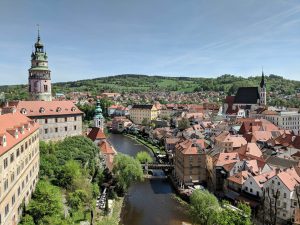 |
| The Fairytale town of Cesky Krumlov |
Terezin and Lidice
The first CEA excursion of the semester was to Terezin, a former Czech Republic fortress used by the Nazis as a concentration camp. We were taken on a tour of the grounds and shown how difficult life really was for the prisoners. As a Jew who had never previously been to a concentration camp, this experience was powerful and overwhelming in an important way. Seeing this place in person put all of the facts and statistics into perspective, and you could feel the shock of everyone on the tour. We were all reminded of just how important it is to never forget this tragedy.
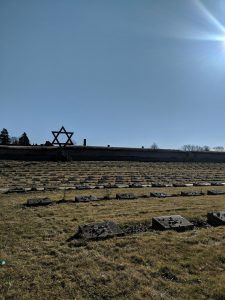 |
| The Jewish cemetery outside of Terezin |
After Terezin we also went to Lidice, a small Czech village that fell victim to a Nazi slaughter after being blamed for the assassination of Nazi official Heydrich. All of the men were killed, the women and children were sent to concentration camps, and the village was burned to the ground. There is a museum there documenting the tragedy of Lidice. The museum played videos of first hand accounts of the surviving children of Lidice. There is also a beautiful memorial to the children of Lidice where the village once stood.
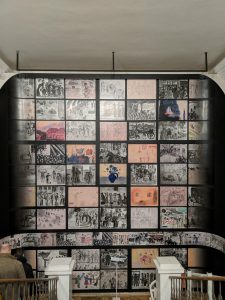 |
| Inside of the Terezin Ghetto Museum |
Kutna Hora
Kutna Hora is a small Czech town that is famous for its cathedral, silver mines, and especially Sedlec Ossuary, A.K.A. the Church of Bones. Made up of the real bones of approximately 40,000 victims of the plague, this church has the strangest atmosphere, both haunting and peaceful. With giant piles of skulls, a coat of arms crafted from bones, and even a bone chandelier, this is a place that really does need to be seen to be believed.
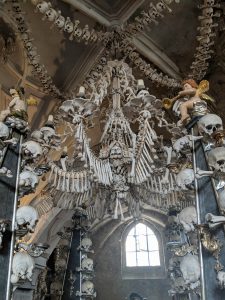 |
| A spooky chandelier made entirely of human bones |
We had a delicious group lunch and visited St. Barbara’s church, another example of beautiful European architecture and especially stain glass windows. At the silver mines, we learned how difficult the job of a miner was. We then got to wear white robes like those of the miners and venture down to their workplace – not recommended for those who are claustrophobic or scared of the dark. When demonstrating how dark it was for the miners, it was impossible to even see my own hand in front of my face. I am very short, and I had to duck down at points to avoid hitting my head. A slightly terrifying but mostly fascinating once-in-a-lifetime experience.
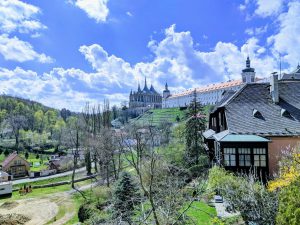 |
| Blue skies over St. Barbara Church |
Cesky Krumlov
Cesky Krumlov is a small medieval town preserved as an UNESCO world heritage site. They have a well preserved Rosenberg Family Castle that demonstrates several different eras of architecture and even has a bear moat. The town itself is something straight out of a fairytale, with it’s medieval buildings, the market and the Vltava river circling it. We were given free time to wander and eat food, and I truly never wanted it to end. We slept over in Cesky Krumlov, then headed to Trisov, where we hiked to the ruins of an abandoned castle. We also visited the Hussite Museum in Tabor, where we toured the underground tunnels that were once cellars to medieval families. As we learned, these were used before people in Europe even had potatoes. This trip introduced me to some of the oldest places I had ever been.
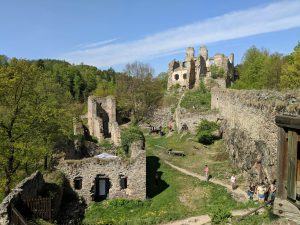 |
| The mysterious ruins of Divci Kamen Castle |
Lindsay G. is the Spring 2018 MOJO Blogger in Prague, Czech Republic. She is currently a Junior studying Screenwriting at Chapman University.







